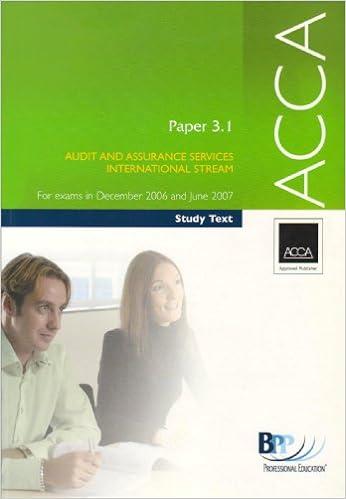Ed Hernandez worked in auto parts stores for most of his life. He began working as a stock clerk in a neighborhood store when he was still in high school, and after graduating from college, he accepted a management position with a national chain of auto parts stores. After working with the large corporation for more than 10 years, he decided to open his own business to serve both the auto repair shops and the general public. The business opened on New Year's Day, 2020. Because of his experience in the industry, he was well known by many of the owners of auto repair shops and residents of his community, and they were happy to hear that he was opening his own store. In the first year of business (2020), the company grossed S290,000 and had an operating profit before tax of $8,000. Although the customers from the general public paid with cash or credit card, Ed offered the auto repair shops 30 days' credit. This was necessary in order to be competitive with other parts stores in the area. The increasing level of accounts receivable, though, placed a great strain on the company cash flow and, because of the lack of cash, Ed found it difficult to replace the inventory as quickly as it was sold. When the business first opened the inventory level was $65,000 and accounts receivable were zero; however, by the end of the first year, accounts receivable were $25,000 and the inventory had dropped to $50,000. Ed's Auto Parts did not have a problem with bad debts; in fact, almost all customers paid within 30 days and only a few took 45 to 60 days to pay. However, the normal 30-day credit was enough of a delay to cause cash problems. Ed was concerned that the drop in inventory could result in lost sales if the customers could not get the parts they needed. He might also start to lose the repair shops as customers if inventory shortages occurred frequently. Ed therefore decided to ask his bank for a loan of $25,000. He planned to use $15,000 to restock inventory to its original level; the remaining $10,000 would be used for working capital. Ed was willing to pledge his home as collateral if necessary; it had a market value of $100,000 and he still owed S40,000 on his mortgage. His personal credit record and that of the business were excellent. Since the economy was strong, Ed felt confident that sales would continue to increase in the coming years. He took the financial statements shown on the next page to his banker to ask for the loan. Ed's Auto Parts Inc Income Statement 1/1/20 to 12/31/20 Sales Cost of coods sold $290,000 Gross profit margin 170 DOG $120,000 $50,000 20.000 15,000 8.000 Expenses Employee Wages Owner Salary Rent Employee taxes Advertising Insurance Utilities Omice supplies Accounting 5.000 4.000 6,000 1.000 3.000 $112.000 Total expenses Operating profit before tax $8.000 Ed's Auto Parts, Inc. Balance Sheet 12/31/20 $25.000 Current Assets Cash Accounts receivable Inventory Supplies Presidentes Current Liabilities 5,000 25.000 Accounts payable 50,000 Current portion of 2.000 long-term debt Accede 8.000 3.000 2000 Total current assets $85,000 Total current liabi $35.000 Fixed Assets Fixtures Equipment Leasehold me Long-Term Liabilities 520,000 15.000 Note Payable Les current 25.000 $80.000 Total xed assets $60.00 Total long-term Babies 572.000 Totallibilities $107.000 Total Assets $145,000 Equity $38.000 Total liabilities & equity $145.000 1. Does Ed have a cash flow problem? Explain your answer? 2. Ed sees the bank loan as a way to deal with his current problems. What else could Ed do to try to deal with his issues with growing accounts receivables and not having the funds to re-stock inventory? 3. Consider Ed's request for $25,000. Is this enough? Ed's Auto Parts Inc. Income Statement 1/1/20 to 12/31/20 $290,000 Sales Cost of goods sold Gross profit (margin) 170.000 $120,000 Expenses Employee Wages Owner salary Rent Employee taxes Advertising Insurance Utilities Office supplies Accounting/legal $50,000 20,000 15,000 8,000 5,000 4,000 6,000 1,000 3.000 $112.000 Total expenses Operating profit before tax $8,000 Ed's Auto Parts, Inc. Balance Sheet 12/31/20 Balance Sheet 12/31/20 $25,000 Current Assets Cash Accounts receivable Inventory Supplies Prepaid expenses Current Liabilities 5,000 25,000 Accounts payable 50,000 Current portion of 2,000 long-term debt Accrued expenses 3,000 8,000 2.000 Total current assets $85,000 Total current liabilities $35,000 Fixed Assets Fixtures Equipment Leasehold Imp. Long-Term Liabilities $20,000 15,000 Note Payable Less: current 25,000 $80,000 (8,000) Total fixed assets $60,000 Total long-term liabilities $72,000 Total liabilities $107.000 Total Assets $145,000 Equity $38,000 Total liabilities & equity $145,000











